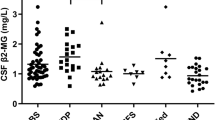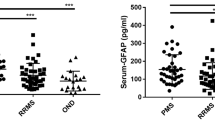Abstract
Guillain–Barré syndrome (GBS) is an immune-mediated inflammatory disease in the peripheral nervous system. Specific biomarkers for the two most common clinical subtypes of GBS, i.e., acute inflammatory demyelinating polyneuropathy (AIDP) and acute motor axonal neuropathy (AMAN) are still missing. The distinctive pathological features of AIDP and AMAN may lead to release of such specific biomarkers including glial markers (calcium-binding astroglial protein, S100B) and axonal damage markers [axoskeletal protein, phosphorylated neurofilament heavy protein (pNFH); cytoskeletal protein, tau], etc. To explore the potentials of biochemical markers for differential diagnosis and evaluation of prognosis of clinical subtypes in GBS, we used ELISA to measure the levels of S100B, tau and pNFH in serum and cerebrospinal fluid (CSF) from the patients with AIDP, AMAN, viral encephalitis and other non-inflammatory neurological disorders (OND), respectively. The values of albumin quotient and IgG index in CSF are significantly higher in AIDP and AMAN than in OND. The levels of S100B, tau and pNFH in serum and CSF are elevated in the patients with AIDP and AMAN compared to OND. The concentrations of these proteins are all higher in CSF than in serum. Increased levels of S100B in CSF at the acute phase are positively correlated with the GBS disability scale scores (GDSs) in AIDP, whereas enhanced levels of tau and pNFH in CSF are positively correlated with the GDSs in AMAN. Increased CSF levels of S100B, tau and pNFH at the acute phase may predict a poor prognosis and evaluate the severity of AIDP or AMAN at plateau and the recovery phase. Elevated levels of pNFH in CSF may be used for differentiating between AMAN and AIDP.



Similar content being viewed by others
References
Hahn AF (1998) Guillain-Barré syndrome. Lancet 352:635–641
Vucic S, Kiernan MC, Cornblath DR (2009) Guillain-Barré syndrome: an update. J Clin Neurosci 16:733–741
Brettschneider J, Petzold A, Süssmuth S, Tumani H (2009) Cerebrospinal fluid biomarkers in Guillain-Barré syndrome—where do we stand? J Neurol 256:3–12
Van Den Bergh PY, Piéret F (2004) Electrodiagnostic criteria for acute and chronic inflammatory demyelinating polyradiculoneuropathy. Muscle Nerve 29:565–574
Hughes RA, Newsom-Davis JM, Perkin GD, Pierce JM (1978) Controlled trial prednisolone in acute polyneuropathy. Lancet 2:750–753
Prineas JW (1981) Pathology of the Guillain-Barré syndrome. Ann Neurol 9(suppl):6–19
Hughes RA, Cornblath DR (2005) Guillain-Barré syndrome. Lancet 366:1653–1666
Hafer-Macko C, Hsieh ST, Li CY et al (1996) Acute motor axonal neuropathy: an antibody-mediated attack on axolemma. Ann Neurol 40:635–644
Van Doorn PA, Ruts L, Jacobs BC (2008) Clinical features, pathogenesis, and treatment of Guillain-Barré syndrome. Lancet Neurol 7:939–950
Mokuno K, Kiyosawa K, Sugimura K et al (1994) Prognostic value of cerebrospinal fluid neuron specific enolase and S-100b protein in Guillain-Barré syndrome. Acta Neurol Scand 89:27–30
Süssmuth SD, Reiber H, Tumani H (2001) Tau protein in cerebrospinal fluid (CSF): a blood-CSF barrier related evaluation in patients with various neurological diseases. Neurosci Lett 300:95–98
Jin K, Takeda A, Shiga Y et al (2006) CSF tau protein: a new prognostic marker for Guillain-Barré syndrome. Neurology 67:1470–1472
Petzold A, Keir G, Green AJ, Giovannoni G, Thompson EJ (2003) A specific ELISA for measuring neurofilament heavy chain phosphoforms. J Immunol Methods 278:179–190
Singh P, Yan J, Hull R et al (2011) Levels of phosphorylated axonal neurofilament subunit H (pNFH) are increased in acute ischemic stroke. J Neurol Sci 304:117–121
Yang YR, Liu SL, Qin ZY et al (2008) Comparative proteomics analysis of cerebrospinal fluid of patients with Guillain-Barré syndrome. Cell Mol Neurobiol 28:737–744
Merkies IS, Schmitz P, Van Der Meche FG et al (2002) Quality of life complements traditional outcome measures in immune-mediated polyneuropathies. Neurology 59:84–91
Petzold A, Hinds N, Murray NM et al (2006) CSF neurofilament levels: a potential prognostic marker in Guillain-Barré syndrome. Neurology 67:1071–1073
Petzold A, Brettschneider J, Jin K et al (2009) CSF protein biomarkers for proximal axonal damage improve prognostic accuracy in the acute phase of Guillain-Barré syndrome. Muscle Nerve 40:42–49
Acknowledgments
This study was supported by Swedish Medical Association, Swedish National Board of Health and Welfare as well as Jilin University as well as grants from Karolinska Institutet.
Author information
Authors and Affiliations
Corresponding author
Rights and permissions
About this article
Cite this article
Wang, XK., Zhang, HL., Meng, FH. et al. Elevated levels of S100B, tau and pNFH in cerebrospinal fluid are correlated with subtypes of Guillain–Barré syndrome. Neurol Sci 34, 655–661 (2013). https://doi.org/10.1007/s10072-012-1092-z
Received:
Accepted:
Published:
Issue Date:
DOI: https://doi.org/10.1007/s10072-012-1092-z




